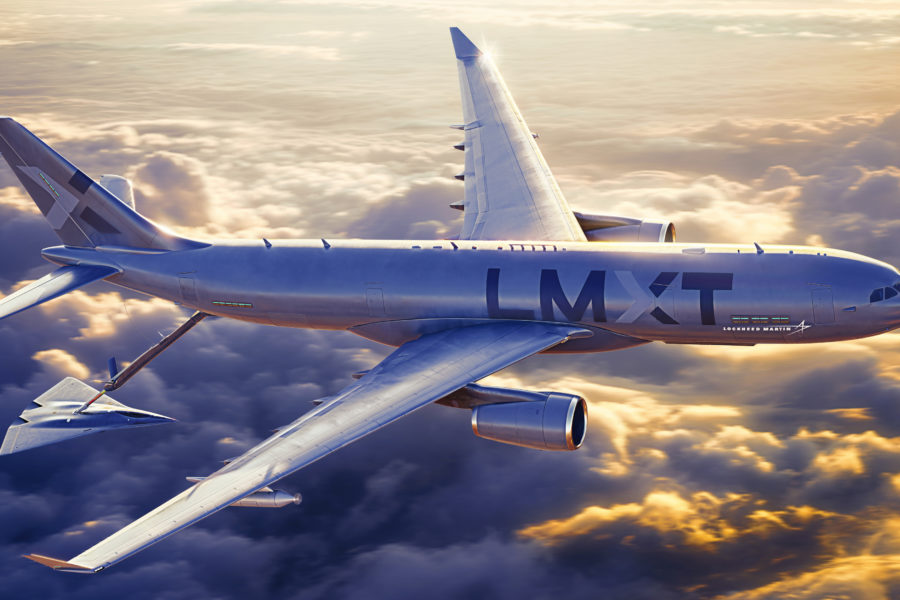Lockheed Martin says it is still pitching its LMXT tanker to the Air Force amid a looming requirements announcement for the KC-Y tanker program. Air Force Secretary Frank Kendall has cast doubt on whether a KC-Y program would field a wholly new aircraft and has said the program may end up being an upgraded KC-46 Pegasus.
However, the KC-46 and its manufacturer Boeing face growing disquiet over numerous delays and problems with the aircraft. The KC-Y is the so-called “bridge tanker” envisioned for production between the current KC-46A and a next-generation KC-Z family of aerial refueling systems.
While the company does not yet know what the requirements of the KC-Y will be, Lockheed Martin said the Air Force has expressed possible interest in a “KC-Y plus,” which the company says could be its LMXT.
“We see this airplane as already being in that KC-Y plus scenario—it is already embodying next-generation technologies,” Lockheed Martin’s LMXT director Larry Gallogly told reporters Oct. 25. “I would certainly say that that’s a potential outcome.”
The Air Force recently announced that necessary updates to the KC-46’s problematic Remote Vision System (RVS) will not be complete until 2025. Lockheed Martin says its offering, which is based on the Airbus A330 Multi-Role Tanker Transport—in service or on order by over a dozen countries—already has the many kinks worked out.
“This is kind of backwards for the U.S. government,” Gallogly said of the LMXT’s development process. “Normally, the U.S. government invests in a weapons system, and we go through all of these growing pains with their weapons system. We get that weapon system up to speed, and our friends and allies get to take advantage of all of that development that we’ve done on that … But our friends and allies have made all of that investment. Now we’re going to get to take advantage of that.”
Lockheed Martin highlighted the fact that the Airbus-designed refueling system for LMXT has undergone numerous improvements over the past decade. Like the KC-46’s RVS, the LMXT uses a screen-based system for operating the main refueling boom.
Lockheed Martin makes the case that the LMXT, a derivative of the commercial Airbus A330 wide-body jet, can also help the Air Force shift toward the Pacific, which it says presents a “tyranny of distance.” Aircraft will need more pit stops to refuel to cover the large area. The Air Force wants to develop the concept of agile combat employment, which means having dispersed operations. Lockheed Martin claims the larger LMXT would support that. With a 271,000-pound fuel capacity, the larger LMXT would carry about 60,000 more pounds of fuel than the KC-46, land at the airbases, and then could operate as a ground refueling station. It could also refuel KC-46s and free them up for other missions. Kendall has repeatedly reiterated his focus on improving the U.S.’s ability to counter China.
“This aircraft does that, I believe, more than any other of the assets that we have,” Gallogly said. “Gas is going to be king.”
As part of the Air Force’s push for flexibility, it plans to use KC-46 as a communications node. Lockheed Martin says the LMXT will have its own dedicated communications hub set up for joint all-domain command and control (JADC2) operations. It will also have a permanent aeromedical suite. This would limit time on the ground needed to configure a plane during which a lumbering tanker could be subject to attack. Airbus’s automatic air-to-air refueling system, which the LMXT would retain, could help reduce the number of crew, or at least their workload. Under Gen. Mike Minihan, Air Mobility Command is pushing for longer sorties with smaller crews.
“Our answer was we’ve designed the configuration so that in 90 percent of the situations, you won’t have to reconfigure this airplane ever,” Gallogly said. “It has all of that all of the time, so it makes it much, much more effective in a combat environment where that time on the ground is critical.”
Still, Lockheed Martin faces a challenging environment if it hopes to sell the LMXT to the U.S. government. The Air Force hopes to push up the timeline on the KC-Z program, which will feature a family of systems for aerial refueling, with some work on the program beginning as soon as 2023. However, if dissatisfaction with Boeing grows over KC-46 delays, Congress could compel the Air Force to have a competition for the KC-Y to prevent the service from relying on a sole source that is already plagued with issues. If not, Lockheed Martin says the LMXT would not die.
“If the competition doesn’t go forward [on the KC-Y], I’m not convinced that the next competition would be for a Z,” Gallogly said. “They may just say, ‘Hey, we’re going to have a competition for the next-generation tanker, and here’s what we want it to do.’ And then we’ll evaluate those requirements and see, does this airplane fit that criteria?”
Ultimately, Lockheed Martin and Boeing are awaiting decisions from the Air Force on what will happen with its future tanker programs.
“Only they know for sure,” Gallogly said.
